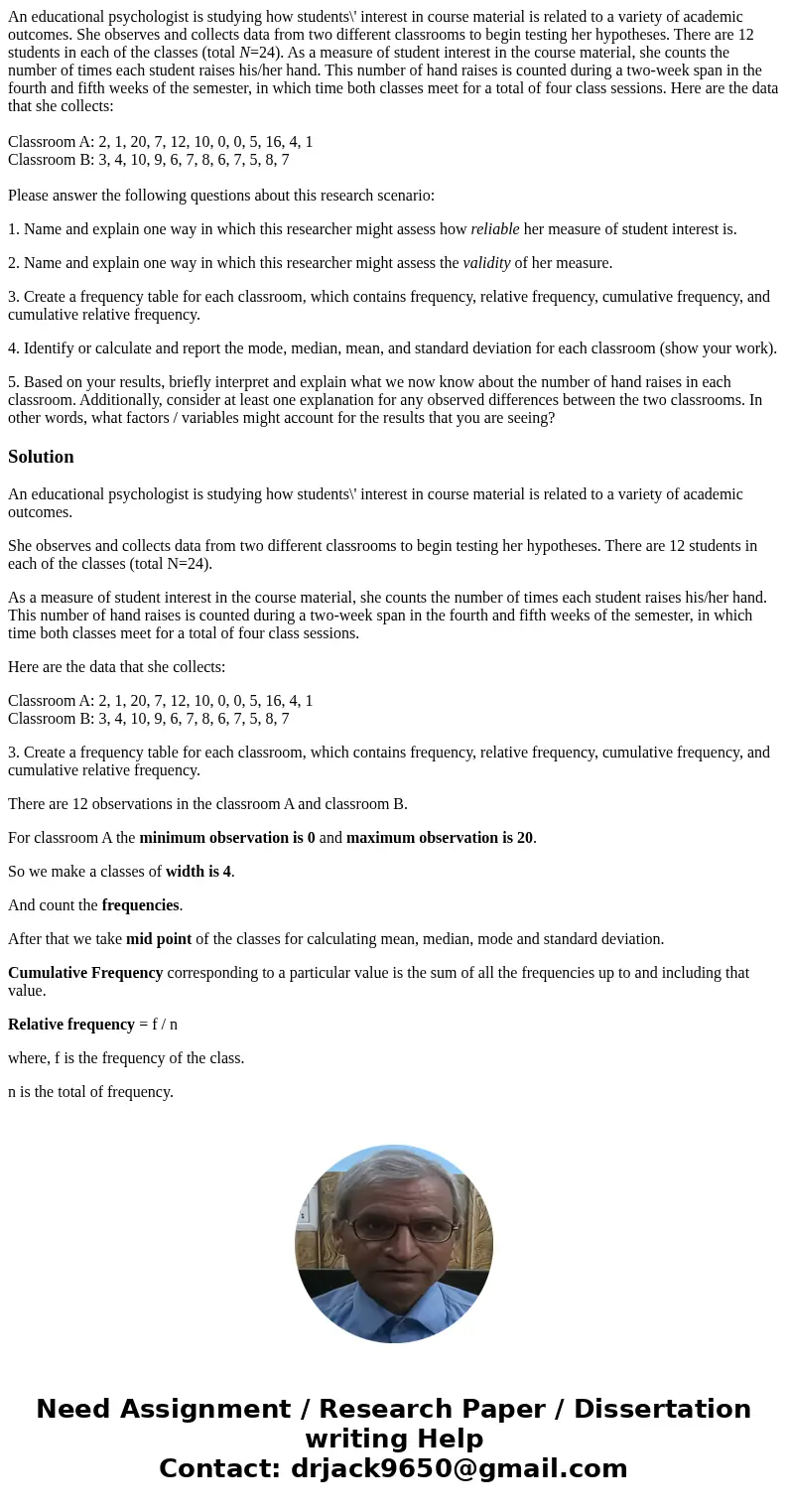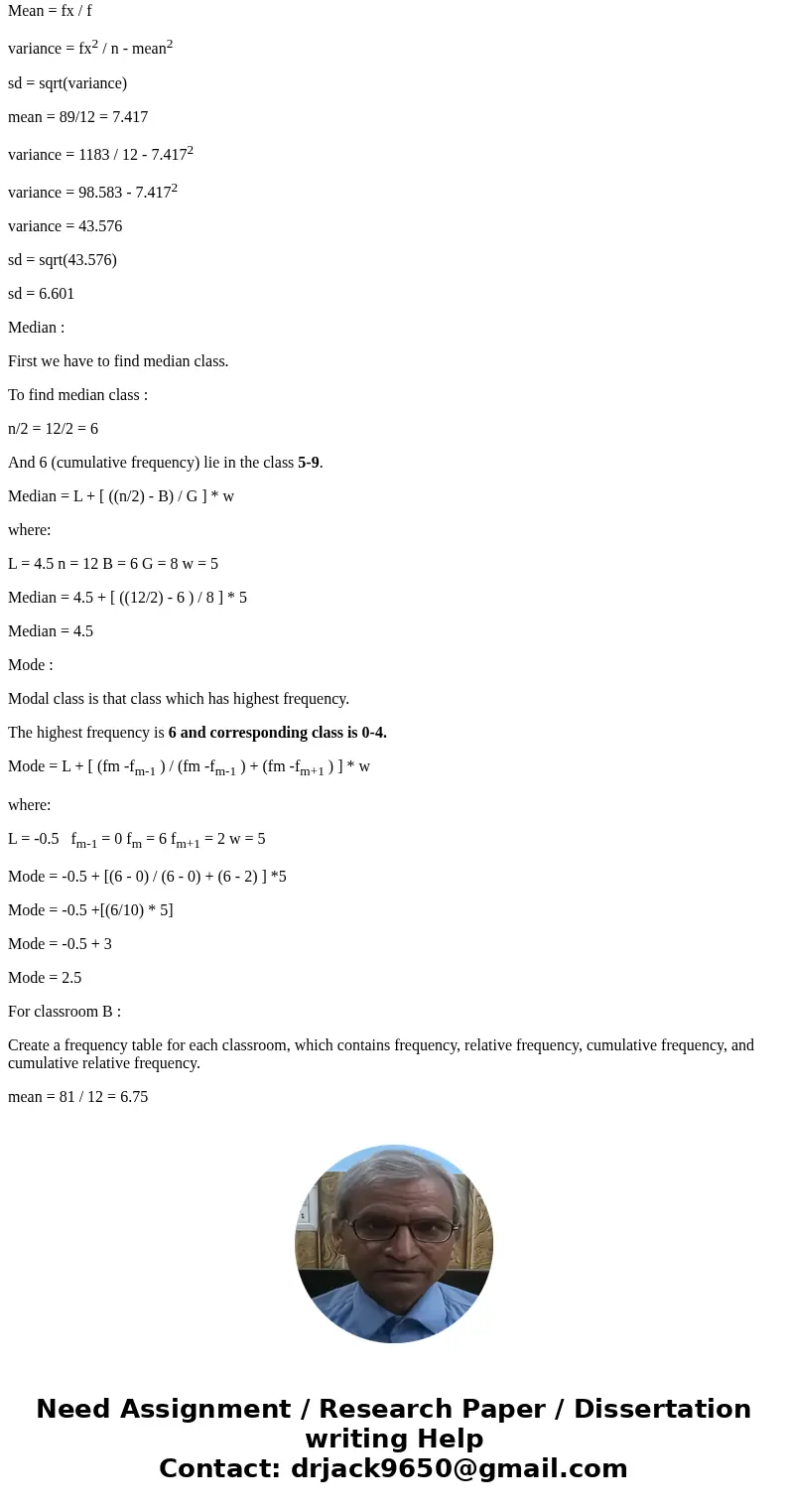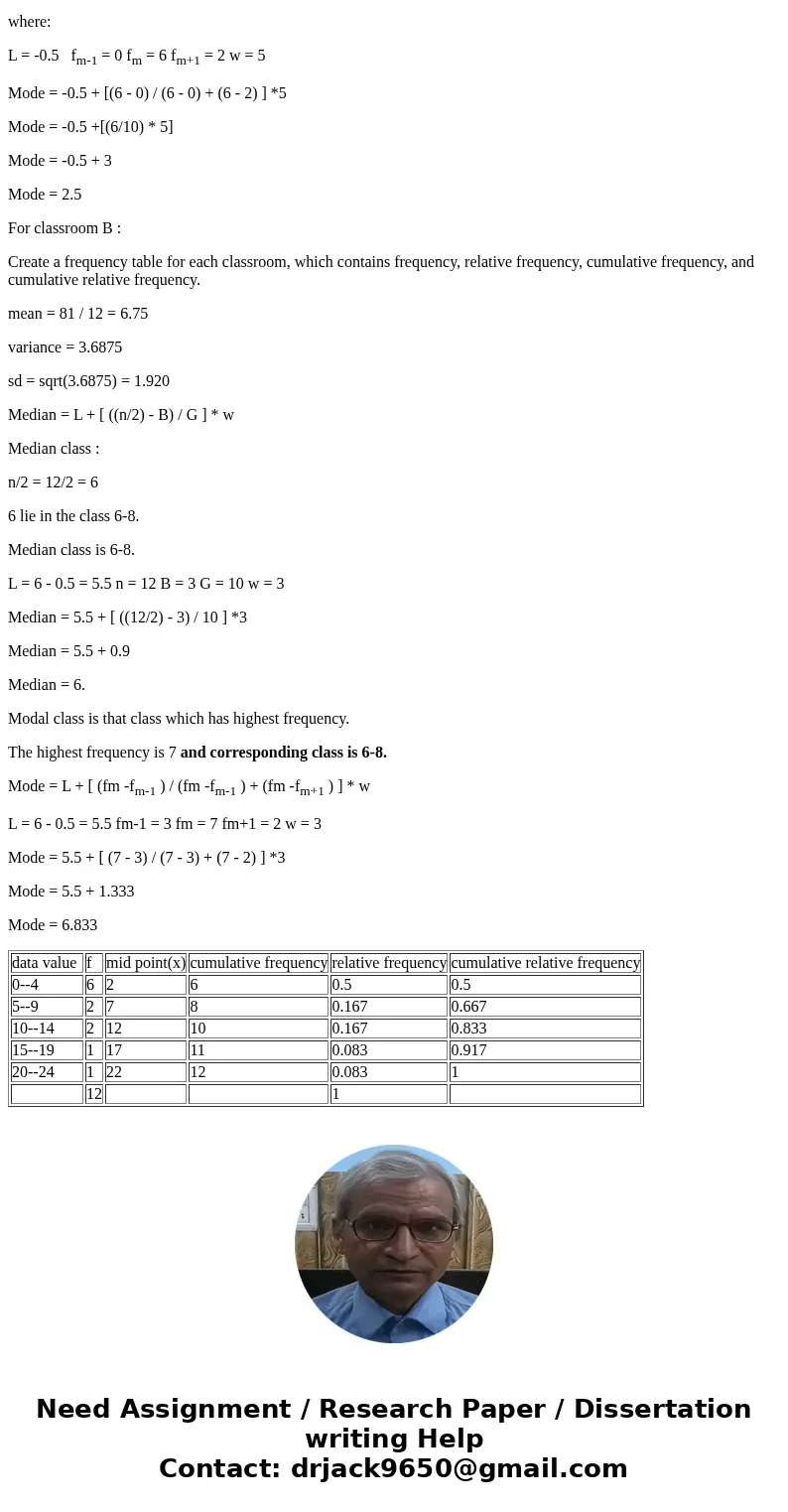An educational psychologist is studying how students interes
An educational psychologist is studying how students\' interest in course material is related to a variety of academic outcomes. She observes and collects data from two different classrooms to begin testing her hypotheses. There are 12 students in each of the classes (total N=24). As a measure of student interest in the course material, she counts the number of times each student raises his/her hand. This number of hand raises is counted during a two-week span in the fourth and fifth weeks of the semester, in which time both classes meet for a total of four class sessions. Here are the data that she collects:
Classroom A: 2, 1, 20, 7, 12, 10, 0, 0, 5, 16, 4, 1
Classroom B: 3, 4, 10, 9, 6, 7, 8, 6, 7, 5, 8, 7
Please answer the following questions about this research scenario:
1. Name and explain one way in which this researcher might assess how reliable her measure of student interest is.
2. Name and explain one way in which this researcher might assess the validity of her measure.
3. Create a frequency table for each classroom, which contains frequency, relative frequency, cumulative frequency, and cumulative relative frequency.
4. Identify or calculate and report the mode, median, mean, and standard deviation for each classroom (show your work).
5. Based on your results, briefly interpret and explain what we now know about the number of hand raises in each classroom. Additionally, consider at least one explanation for any observed differences between the two classrooms. In other words, what factors / variables might account for the results that you are seeing?
Solution
An educational psychologist is studying how students\' interest in course material is related to a variety of academic outcomes.
She observes and collects data from two different classrooms to begin testing her hypotheses. There are 12 students in each of the classes (total N=24).
As a measure of student interest in the course material, she counts the number of times each student raises his/her hand. This number of hand raises is counted during a two-week span in the fourth and fifth weeks of the semester, in which time both classes meet for a total of four class sessions.
Here are the data that she collects:
Classroom A: 2, 1, 20, 7, 12, 10, 0, 0, 5, 16, 4, 1
Classroom B: 3, 4, 10, 9, 6, 7, 8, 6, 7, 5, 8, 7
3. Create a frequency table for each classroom, which contains frequency, relative frequency, cumulative frequency, and cumulative relative frequency.
There are 12 observations in the classroom A and classroom B.
For classroom A the minimum observation is 0 and maximum observation is 20.
So we make a classes of width is 4.
And count the frequencies.
After that we take mid point of the classes for calculating mean, median, mode and standard deviation.
Cumulative Frequency corresponding to a particular value is the sum of all the frequencies up to and including that value.
Relative frequency = f / n
where, f is the frequency of the class.
n is the total of frequency.
Mean = fx / f
variance = fx2 / n - mean2
sd = sqrt(variance)
mean = 89/12 = 7.417
variance = 1183 / 12 - 7.4172
variance = 98.583 - 7.4172
variance = 43.576
sd = sqrt(43.576)
sd = 6.601
Median :
First we have to find median class.
To find median class :
n/2 = 12/2 = 6
And 6 (cumulative frequency) lie in the class 5-9.
Median = L + [ ((n/2) - B) / G ] * w
where:
L = 4.5 n = 12 B = 6 G = 8 w = 5
Median = 4.5 + [ ((12/2) - 6 ) / 8 ] * 5
Median = 4.5
Mode :
Modal class is that class which has highest frequency.
The highest frequency is 6 and corresponding class is 0-4.
Mode = L + [ (fm -fm-1 ) / (fm -fm-1 ) + (fm -fm+1 ) ] * w
where:
L = -0.5 fm-1 = 0 fm = 6 fm+1 = 2 w = 5
Mode = -0.5 + [(6 - 0) / (6 - 0) + (6 - 2) ] *5
Mode = -0.5 +[(6/10) * 5]
Mode = -0.5 + 3
Mode = 2.5
For classroom B :
Create a frequency table for each classroom, which contains frequency, relative frequency, cumulative frequency, and cumulative relative frequency.
mean = 81 / 12 = 6.75
variance = 3.6875
sd = sqrt(3.6875) = 1.920
Median = L + [ ((n/2) - B) / G ] * w
Median class :
n/2 = 12/2 = 6
6 lie in the class 6-8.
Median class is 6-8.
L = 6 - 0.5 = 5.5 n = 12 B = 3 G = 10 w = 3
Median = 5.5 + [ ((12/2) - 3) / 10 ] *3
Median = 5.5 + 0.9
Median = 6.
Modal class is that class which has highest frequency.
The highest frequency is 7 and corresponding class is 6-8.
Mode = L + [ (fm -fm-1 ) / (fm -fm-1 ) + (fm -fm+1 ) ] * w
L = 6 - 0.5 = 5.5 fm-1 = 3 fm = 7 fm+1 = 2 w = 3
Mode = 5.5 + [ (7 - 3) / (7 - 3) + (7 - 2) ] *3
Mode = 5.5 + 1.333
Mode = 6.833
| data value | f | mid point(x) | cumulative frequency | relative frequency | cumulative relative frequency |
| 0--4 | 6 | 2 | 6 | 0.5 | 0.5 |
| 5--9 | 2 | 7 | 8 | 0.167 | 0.667 |
| 10--14 | 2 | 12 | 10 | 0.167 | 0.833 |
| 15--19 | 1 | 17 | 11 | 0.083 | 0.917 |
| 20--24 | 1 | 22 | 12 | 0.083 | 1 |
| 12 | 1 |



 Homework Sourse
Homework Sourse